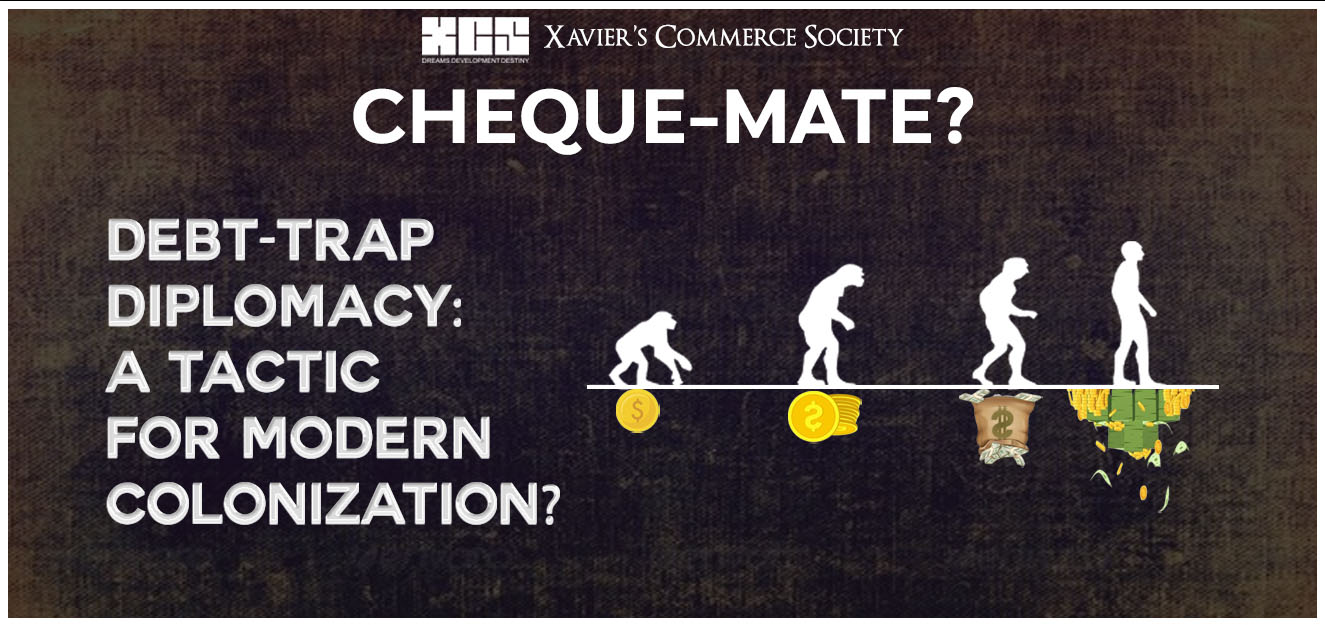


Cheque-Mate?
It strikes ironic that China, a country often regarded as 'the factory of the world', is the one that is investing billions of dollars in other countries, contrary to its name. China has been implementing one of the most alarming and tactical strategies by means of which it is asserting its influence and dominance on several countries. Upon considerable deliberation, two Harvard University graduates christened the scheme as the Chinese 'Debt-Book Diplomacy'.
Debt-trap diplomacy involves a wealthy nation lending to comparatively poorer nations which are resource-rich or strategically located, and saddling them with unmanageable debts. Because of this, the poorer nations are forced to give up their strategic assets or yield to political pressure. It speaks of connotations of colonization, and echoes the words of John Adams, “There are two ways to conquer and enslave a nation. One is by the sword. The other is by debt.”
Thus, debt-trap diplomacy is an international financial relationship in which a creditor country or institution advances debt to a borrowing nation partially or exclusively to improve the lender's political influence. When a debtor country is unable to make its repayment commitments, the creditor country is considered to have given it an excessive amount of credit with the goal of obtaining political or economic concessions from it. The terms of the loans are frequently not made public. Contractors and supplies from the nation of the creditor are frequently purchased using the borrowed funds. The consequences of defaulting on its debts include entrapment to gain influence and power over these regions.
While there are some questions, the answers to which are open to debate, the answer to this one is absolutely vivid and there for everyone else to see. China is in the midst of a rapid push to gain economic and political traction across the Asia-Pacific and the Central and East European corridors, and hence, is extending billions of dollars across the globe in the form of concessional loans to developing countries for infrastructure projects.
One such prominent example of the above is Sri Lanka - a country that outrightly fell for China's Debt Trap Policy. Massive protests and civilian unrest erupted last year when Sri Lanka was called to hand over control of the failed Hambantota Port Project over to China after it found itself in over billions of dollars of debt to Beijing. This resulted in China controlling a key port on the doorstep of its regional rival, India, as well as having a strategic foothold along a viral commercial and military waterway, a little closer to home.
This forbears greater global ramifications in its wake. One common narrative between the ongoing crises in Pakistan, Nepal and Sri Lanka is that they all form a part of China’s Belt and Road Initiative (BRI). Chinese investors are planning to make investments in roughly 70 nations as part of the BRI, a global infrastructure development initiative. Through BRI, the Chinese government makes investments in the construction of ports, highways, bridges, dams, power plants, trains, etc. China is reported to have BRI agreements with each of the three nations.
With China's influence spreading, India has been attempting to fortify its borders by promoting 'human-centric growth', focusing on providing massive humanitarian relief programmes and funds for aiding the country out of its economic and political upheaval. Sri Lanka has been given a $2.5 billion credit line by India to help out in the relief efforts. Additionally, it provided Sri Lanka with a $500 million credit line for petroleum imports as well as a $400 million currency exchange. India is striving to maintain its influence in the region and prevent China from shadowing its other borders in order to defend its strategic interest in the area and oppose the debt trap tactics through cooperative measures and humanitarian help. In this manner, it has been seeking to promote its image as a dependable and trustworthy partner, whose help and aid does not come with several veiled vested interests.
The United States has also engaged in direct as well as proxy conflicts with China. Whether it be pointing out China’s sinister motives in global institutions and bodies; addressing the Chinese behavior in the region as 'coercive to human rights and democracy', or levying international trade embargoes on the import and export of products and services, it has, despite unsuccessful attempts, been trying to alienate China from the rest of the world.
China has been attacking the world order in a covert-but-adept modus operandi. “From the outside, it markets its ideas, governance, and development model as superior to the West’s; from the inside, it works within the very institutions and networks that bind the U.S. order together.” Will the nations of the world unite and collectively outwit China and its Debt Trap Diplomacy, re-establish the liberal world order promulgated to ensure autonomy and freedom, as well as ameliorate the makings of a further global military conflict? Or, will China emerge victorious in this game of absolutes, threatening to impel the world into a new age of darkness, and escalate political tensions to catastrophic levels, leading to downright coercion and intimidation in the global fabric?